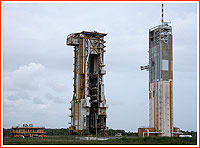| |
|
Searching for details: The author of this page will appreciate comments, corrections and imagery related to the subject. Please contact Anatoly Zak. |
After its heyday in the 1980s and 1990s, the ELA-2 launch complex stood abandoned at the turn of the 21st century. Copyright © 2008 Anatoly Zak The successful introduction of the Ariane rocket, achieved in 1979, prompted Europe to expand its launch facilities in Kourou, French Guiana. In 1981, the European Space Agency, ESA, received the go-ahead to develop a second launch pad for follow-on versions of the Ariane rocket. Designated ELA-2, the facility promised higher turnaround for each mission than was possible at the original launch complex, essentially making Ariane an operational rocket. In total, ELA-2 hosted 119 missions of the Ariane 2, 3 and 4 vehicles during 17 years from 1986 to 2003. Launch Complex No. 2 As with other major facilities in Kourou, the European Space Agency delegated its French counterpart CNES to develop and build the ELA-2 facility. The site would then be transferred to Arianespace, a commercial company responsible for the operational use of the Ariane family of rockets. The facility was located two kilometers northwest of the weather station of Guiana Space Center. The Ariane-3 rocket would fly from ELA-2 during the facility's initial phase of operation, however, the ultimate goal of the complex was to accommodate the taller and more powerful Ariane-4. Unlike was the case with the original Ariane pad, the ELA-2 facility was split into two areas -- a launcher preparation zone and the launch pad itself, located 950 meters away. The rocket would be moved from its processing building to the launch pad in vertical position on a mobile launch platform along two railway lines. With a pair of launch platforms available, two missions could be prepared: one on the launch pad and one in the assembly building. Thus, ELA-2 facility could handle 10-12 missions annually. Theoretically, rockets could be fired from the single ELA-2 pad every three weeks. A special mobile gantry at ELA-2 provided a protected environment for final preparation of the Ariane 2, 3 and 4 vehicles after their transfer to the launch pad – including payload installation. It was rolled back to a parked position prior to the vehicle’s liftoff. Development of the complex As of 1982, the civil engineering phase of construction at ELA-2 was moving forward in full gear. At the time the installation of equipment was expected to start in the middle of 1983. The validation of the facility was scheduled for the first quarter 1984. The ELA-2 would then be declared operational by November 1984. If everything went according to schedule, the first rocket, Ariane-3, would fly from ELA-2 in March 1985. By the end of 1983, the first launch from the ELA-2 pad was expected at the end of 1985. Around the same time, the first launch of the Ariane-4 rocket was scheduled in February 1986. (FI, Oct. 22, 1983) In reality, ELA-2 was put to the test for the first time on March 28, 1986, with the launch of an Ariane 3 rocket (flight V17). The facility was then upgraded for Ariane-4 launches, which started with flight V22 on June 15, 1988. This complex was used for all Ariane-4 launches until the rocket's last mission, V159, on February 15, 2003. ELA-2 was phased out of operation in February 2003 when Ariane 5 assumed the full duties for Arianespace’s commercial missions at the Spaceport. After the retirement of the Ariane-4 rocket, Arianespace was not quite sure what to do with the ELA-2 facility. After few years of inaction, the corrosive effects of the South-American weather showed themselves on the rusted surfaces of the gantries and the launch platform. In 2008, the main structures of the ELA-2 launch pad were still standing, however, an eventual demolition of the facility looked likely. (280) ELA-2 to pave the way for Ariane-6? In September 2011, the 80-meter tall mobile gantry at ELA-2 was brought down by pyrotechnic charges that are similar to those used for separating an Ariane launcher’s stages during flight. Metal recovered from the gantry is being cut up, compressed and shipped to Europe for recycling or disposal in specialized centers. Dismantlement of the ELA-2 site began in July 2011, with the work to be completed by year-end. This activity was performed under a mandate of the European Space Agency – which owns the Spaceport’s facilities and is the design authority for Ariane launchers. The work was carried out by France’s CNES space agency, the Ariane program prime contractor and the Spaceport’s operator. As the Spaceport’s launch infrastructure user, Arianespace was assigned the responsibility of removing pollution sources from the ELA-2 propellant feed lines. Some elements of the ELA-2 infrastructure were to have a new life in service, as certain designated facilities were to be reutilized to support Ariane 5 and Soyuz launch activity. Also, there were plans to convert ELA-2 to support the Ariane 5 ME and Ariane 6 launchers.
Page author: Anatoly Zak; Last update: September 29, 2011 Page editor: Alain Chabot; Last edit: May 23, 2008 All rights reserved |
IMAGE ARCHIVE The Ariane-4 rocket blasts off from the ELA-2 pad in Kourou. Click to enlarge Credit: Arianespace 
Key elements of the ELA-2 launch zone: mobile launch platform (left), mobile service tower (center) and a gantry (right). Click to enlarge Copyright © 2008 Anatoly Zak Guiana's rain-soaked weather takes little time to leave its mark on all man-made structures. Click to enlarge Copyright © 2008 Anatoly Zak Karouabo Creek borders the ELA facilities on the west. Click to enlarge Copyright © 2008 Anatoly Zak |